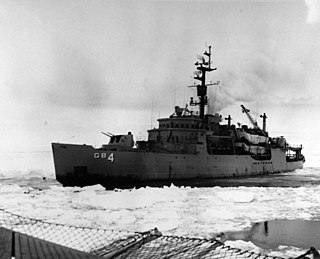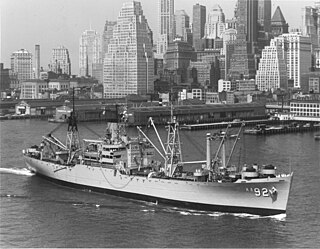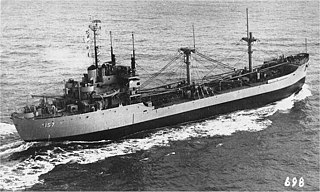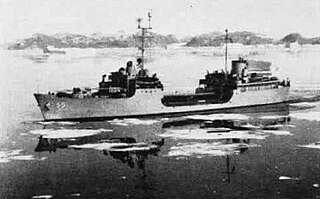Service history
World War II
Whitewood tended and laid nets and buoys at Boston, Mass., and at Newport and Melville, R.I., through the remainder of 1944 and into 1945. After a drydocking which began at the Boston Navy Yard in March 1945, the net layer shifted to Portland, Maine, in July. There she worked out of the Navy Net Depot at Little Diamond Island through the end of World War II in August 1945. After shifting to Newport, R.I., at the end of the month, she provided services for the naval net depot there and assisted in laying experimental net installations off Block Island.
Operation Nanook
Although apparently slated for inactivation on 22 October 1945, Whitewood apparently remained in commission through the end of the year. Early in 1946, the ship was placed in "deferred disposal" status pending possible future use. On 11 April, she was selected to participate in Operation Nanook, Arctic exercises slated to take place in the summer of 1946. Taken to the Boston Naval Shipyard, the ship was under conversion for the rest of the spring and into the summer. During this time, on 20 May, a fire broke out on board the ship in one of her after storerooms and caused "Nanook's" planners to fear that the wooden-hulled ship's services would be lost to the pending operation. Fortunately, the fire was put out before major damage occurred; and the shipyard was able to repair the ship enabling her to take part in "Nanook" as scheduled.
The nucleus of the "Nanook" force, Task Force (TF) 68, consisted of Norton Sound (AVM-1), Atule (SS-403), USCGC Northwind (WAGB-282), Alcona (AK-157), Beltrami (AK-162) and Whitewood. On 3 July, Whitewood departed Boston to rendezvous with Northwind off Greenland.
For the remainder of July and into August, Whitewood operated in the Canadian Arctic, off western Greenland. She transited the Davis Strait to the northern part of Baffin Bay in company with Northwind and Atule and conducted exercises en route. All ships in TF 68 except the two AK's eventually rendezvoused at Melville Bight, Baffin Bay, on 20 July. Whitewood and Atule subsequently accompanied Norton Sound to Thule harbor to recover a PBM Mariner forced down with engine trouble.
From 22 July to 5 August, all activities in "Nanook" centered around Thule; Norton Sound remained at anchor there, in North Star Bay, servicing her two PBM's. Meanwhile, Whitewood and Atule operated from North Star Bay as they conducted exercises and tests in the Smith Sound – Kane Basin area. On 5 August, Norton Sound and Whitewood headed for Dundas Harbor, Devon Island, to attempt air and surface operations there. Unfortunately, the ships found the harbor iced over, with a belt of pack ice extending out three miles down the coast. Northwind later joined the two ships in the vicinity of Dundas Harbor, searching for a suitable anchorage that could accommodate the ships and their attached aircraft. Whitewood succeeded in finding a small, ice-free anchorage at Tay Bay, off northwestern Bylot Island.
In the ensuing weeks, Whitewood reconnoitered the coastal areas in Lancaster, Eclipse, and Jones Sounds, and Prince Regent, Admiralty, and Navy Board Inlets. Operating on this duty in company with Northwind, Whitewood landed shore parties that set up positions ashore to obtain terrestrial navigation "fixes" to dovetail with the photographic coverage obtained from the ships and planes of the project's task force.
Eventually, the summer Arctic weather deteriorated to the point where it hindered Whitewood's surveying efforts — especially her terrestrial fixes. Released from the expedition in early September, Whitewood received her sailing orders on 6 September and soon set her course for Boston. She arrived there on 19 September for repairs.
Reclassified as (AG)
While at Boston, Whitewood was reclassified a miscellaneous auxiliary (AG) on 14 January 1947 and was given the alphanumeric hull number AG-129. She conducted refresher training in Chesapeake Bay soon thereafter and returned to Boston on 9 July to prepare for the next round of Arctic operations.
Return to the Arctic
She sailed for the Canadian Arctic in company with the Navy's newest icebreaker, Edisto, to participate in the successor to Operation "Nanook." The basic missions for TF 68 in this Arctic stint were the resupply of existing weather stations and the establishment of a new one at Melville Harbor, Ville Island.
Whitewood performed reconnaissance and survey work during the expedition, while Wyandot (AKA-92) completed her assigned task, supplying the weather station at Thule. When Whitewood and Edisto tried to force their way through the ice to deliver needed supplies to the station at Slidre Fjord, the heavy pack ice damaged Whitewood's bow sheathing, steering engine, and propeller, necessitating her return to Boston for repairs. After transferring her cargo to Edisto — which eventually forced her way through the pack ice to Slidre Fjord — Whitewood headed home.
Whitewood underwent repairs at Boston between 1 September and 18 October before sailing for Bayonne, N.J., for an overhaul that lasted through the end of October. She headed back northward and operated out of Argentia, Newfoundland; and Grondal and Søndre Strømfjord, Greenland; into late 1948 supporting the International Ice Patrol. During the tour, she touched at such ports as Narsarssuak, Grondal, Argentia, and Breton.
On 6 December 1948, while the ship was operating in heavy pack ice, a shifting floe sprung a leak in her port chain locker. A seam opened there, and the ship began to fill uncontrollably. In order to save the ship, her commanding officer, Lt. Cpmdr. F. E. Clark, ordered her beached. Meanwhile, Edisto, which had just completed refresher training in Narragansett Bay, was summoned to join Hoist (ARS-40) in assisting Whitewood out of her predicament. Eventually, with a patch applied to her side, Whitewood made Boston on 8 January 1949 — exactly one month after her serious accident.
Subsequently, cleared for disposal on 12 March, she was decommissioned at Newport on 1 April and struck from the Navy list on 7 June. She was then sold to Walter H. Wimms of Los Angeles, Calif., on 3 March 1950 and scrapped.

George Washington De Long was a United States Navy officer and explorer who led the ill-fated Jeannette expedition of 1879–1881, in search of the Open Polar Sea.

USS Atule (SS/AGSS-403), a Balao-class submarine, was the only ship of the United States Navy to be named for the atule.

Operation Nanook was an Arctic expedition undertaken by the United States Navy in 1946. It consisted of USS Norton Sound (AV-11), USS Atule (SS-403), USCGC Northwind (WAG-282), USS Alcona (AK-157), USS Beltrami (AK-162), and USS Whitewood (AN-63). The mission is mostly documented as cartographic in nature.

The first USS Advance was a brigantine in the United States Navy which participated in an Arctic rescue expedition. Advance was built in 1847 as Augusta in New Kent County, Virginia and loaned to the Navy on 7 May 1850 by Henry Grinnell to participate in the search for Sir John Franklin's Arctic expedition which had been stranded in the frozen north since 1846. After last-minute preparations, the ship, under the command of Lieutenant Edwin J. De Haven and in company with Rescue, put to sea from New York on 23 May 1850.

Nares Strait is a waterway between Ellesmere Island and Greenland that connects the northern part of Baffin Bay in the Atlantic Ocean with the Lincoln Sea in the Arctic Ocean. From south to north, the strait includes Smith Sound, Kane Basin, Kennedy Channel, Hall Basin and Robeson Channel. Nares Strait has a nearly permanent current from the north, powered by the Beaufort Gyre, making it harder to traverse for ships coming from the south.

USS Edisto (AGB-2) was a Wind-class icebreaker in the service of the United States Navy and was later transferred to the United States Coast Guard as USCGC Edisto (WAGB-284). She was named after Edisto Island, South Carolina. The island is named after the Native American Edisto Band who inhabited the island and the surrounding area. As of 2011 there is a namesake cutter USCGC Edisto (WPB-1313). The newer Edisto is a 110-foot Island-class patrol boat and is stationed in San Diego County, California.

USS Glacier (AGB-4) was a U.S. Navy, then U.S. Coast Guard icebreaker which served in the first through fifteenth Operation Deep Freeze expeditions. Glacier was the first icebreaker to make her way through the frozen Bellingshausen Sea, and most of the topography in the area is named for her crew members. When built, Glacier had the largest capacity single armature DC motors ever installed on a ship. Glacier was capable of breaking ice up to 20 feet (6.1 m) thick, and of continuous breaking of 4-foot (1.2 m) thick ice at 3 knots.

USCGC Northwind (WAG/WAGB-282) was a Wind-class icebreaker, the second United States Coast Guard Cutter of her class to bear the name. She was built to replace USCGC Staten Island which was in Soviet lend-lease service.

The first USS Rescue was a brig in service with the United States Navy.

USS Wyandot (AKA-92) was an Andromeda-class attack cargo ship named after Wyandot County, Ohio. She served as a commissioned ship for 20 years and 1 month.

USS Arneb (AKA-56/LKA-56) was an Andromeda-class attack cargo ship named after Arneb, the brightest star in the southern constellation Lepus. She served as a commissioned ship for 27 years and 3 months, the longest time in commission of any AKA.

USCGC Staten Island (WAGB-278) was a United States Coast Guard Wind-class icebreaker. Laid down on 9 June 1942 and launched on 28 December 1942, the ship was commissioned on 26 February 1944, and almost immediately afterward transferred to the Soviet Union, under the Lend Lease program, under the name Severny Veter, which loosely translates as Northwind, until 19 December 1951. When returned to the United States Navy, she was designated USS Northwind until 15 April 1952, when she was renamed Staten Island to distinguish her from her successor USCGC Northwind (WAGB-282) which had been laid down shortly after she was lent to the Soviet Union. The ship was transferred to the U.S. Coast Guard as USCGC Staten Island in February 1965, and served until November 1974, before being scrapped.

USS Alcona (AK-157) was an Alamosa-class cargo ship commissioned by the U.S. Navy for service in World War II. She was responsible for delivering troops, goods and equipment to locations in the war zone.

USS Beltrami (AK-162) was an Alamosa-class cargo ship commissioned by the U.S. Navy for service in World War II. She was responsible for delivering troops, goods and equipment to locations in the war zone.

USS Nespelen (AOG-55) was a Patapsco-class gasoline tanker in the service of the United States Navy.

USS Lindenwald (LSD-6) was an Ashland-class dock landing ship of the United States Navy, named in honor of Lindenwald, the New York estate of President Martin Van Buren (1782–1862).

The third USS Tigress was a screw steamer of the United States Navy, chartered during 1873 to mount an Arctic rescue mission.
North Star Bay, also known as Thule Harbor and Wolstenholme Bay, is a bay off the mouth of Wolstenholme Fjord, Greenland.
Wolstenholme Island is an island in Baffin Bay, in Avannaata municipality, off northwestern Greenland.















